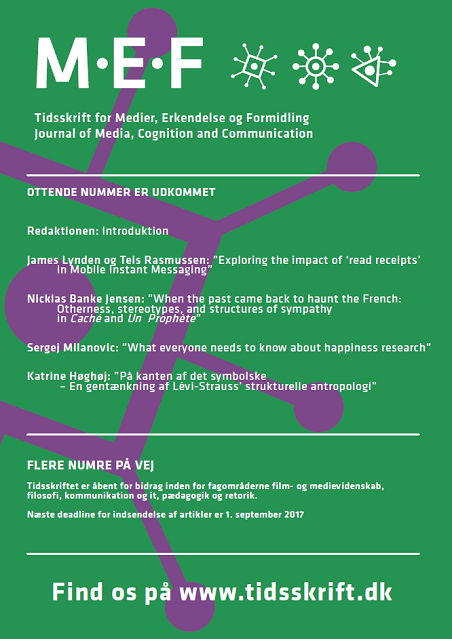When the past came back to haunt the French: Otherness, stereotypes, and structures of sympathy in <em>Caché</em> and <em>Un Prophète</em>
Resumé
RESUMÉ
Denne artikel undersøger hvordan Un Prophète (2009, Jacques Audiard) og Caché (2005, Michael Haneke) anvender sympatistrukturer til at udfordre bestemte stereotypiske fremstillinger af ’fremmede’ i Frankrig – i både historisk samt nutidig kontekst. Filmene anlægger vidt forskellige strategier hertil: Caché læses som en allegori over Frankrigs behandling af algeriere (særligt i kølvandet på Paris-massakren i 1961), og anvender et misforhold mellem alignment- og allegiance-strukturer til at udstille Frankrigs position ift. indvandrere som paranoid og hyklerisk. Un Prophète demonstrerer den relativitet, der knytter sig til national identitet, ved at aligne seeren med ”den fremmede”, som i narrativet viser sig at fortjene sympati.
ABSTRACT
This article investigates how Un Prophète (2009, Jacques Audiard) and Caché (2005, Michael Haneke) make use of sympathy structures to challenge stereotypes of ‘others’ in France – in both historical and contemporary contexts. The films employ vastly different strategies: Caché reads like an allegory of the French treatment of Algerians and uses a disparity between alignment and allegiance structures to expose the French attitude towards immigrants as paranoid and hypocritical. Un Prophète demonstrates the relativity connected to the concept of national identity by aligning the viewer with “the other”, who shows himself in the narrative to be worthy of sympathy.
Downloads
Publiceret
Citation/Eksport
Nummer
Sektion
Licens
Creative Commons: CC by-nc-nd


